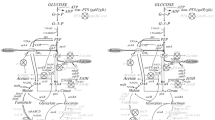Abstract
In lactose and leucine-limited continuous cultures of Streptococcus cremoris a linear relationship exists between specific rate of lactate production and specific growth rate. The rate of acid production in leucine-limited cultures is much higher than in lactose-limited cultures, indicating that under these conditions metabolic energy production is not coupled to growth and that metabolic energy has to be dissipated S. cremoris contains phosphofructokinase and fructose-1,6-diphosphatase, joint action of these two enzymes results in an ATP consuming futile cycle. Analyses of intracellular metabolite pools suggested that AMP and phosphoenolpyruvate play important roles in the regulation of the activity of this futile cycle.
Similar content being viewed by others
Abbreviations
- PEP:
-
Phosphoenolpyruvate
- PFK:
-
phosphofructokinase (EC 2.7.1.11)
- FBPase:
-
fructose-1,6-bisphosphatase (EC 3.1.3.11)
References
Chapman AG, Atkinson DE (1977) Adenine nucleotide concentrations and turnover rates. Their correlations with biological activity in bacteria and yeasts. Adv Microbiol Physiol 15:253–306
Cooper RA, Anderson A (1970) The formation and catabolism of methylglyoxal during glycolysis in Escherichia coli. FEBS Lett 11:273–276
Crow VL, Wittenberger CL (1979) Separation and properties of NAD+ and NADP+-dependent glyceraldehyde-3-phosphate dehydrogenase from Streptococcus mutans. J Biol Chem 254:1134–1142
Fordyce AM, Moore CH, Pritchard GG (1982) Phosphofructokinase from Streptococcus lactis. In: Wood WA (ed) Methods in enzymology, vol 90. Academic Press, London, pp 77–82
Fraenkel DG, Horecker BL (1965) Fructose-1,6-diphosphatase and acid hexose phosphatase of Escherichia coli. J Bacteriol 90:837–842
Herbert D, Phipps PJ, Strange RE (1971) Chemical analysis of microbial cells. In: Norris JR, Ribbons DW (eds) Methods in microbiology, vol 5B. Academic Press, London New York, pp 209–344
Lazdunski A, Belaich JP (1972) Uncoupling in bacterial growth: ATP pool variation Zymomonas mobilis in relation to different uncoupling conditions of growth. J Gen Microbiol 70:187–197
Lowry OH, Rosenbrough NJ, Farr AL, Randall RJ (1951) Protein with the Folin Phenol reagent. J Biol Chem 193:265–275
Maloney PC (1977) Obligatory coupling between proton entry and the synthesis of adenosine 5′-triphosphate in Streptococcus lactis. J Bacteriol 132:564–575
Newsholme EA, Start C (1973) Regulation in metabolism. Wiley & Sons, Chichester, UK
Otto R, Sonnenberg ASM, Veldkamp H, Konings WN (1980) Generation of an electrochemical proton gradient in Streptococcus cremoris by lactate efflux. Proc Natl Acad Sci USA 77:5502–5506
Otto R, Lageveen RM, Veldkamp H, Konings WN (1982) Lactate efflux-induced electrical potential in membrane vesicles of Streptococcus cremoris. J Bacteriol 149:733–738
Otto R, Brink B ten, Veldkamp H, Konings WN (1983) The relation between growth rate and electrochemical proton gradient of Strepococcus cremoris. FEMS Microbiol Lett 16:69–74
Otto R, Klont B, ten Brink B, Konings WN (1984) The phosphate potential, adenylate energy charge and proton motive force in growing cells of Streptococcus cremoris. Arch Microbiol
Pirt SJ (1975) Principles of microbe and cell cultivation. Blackwell Scientific Publications. Oxford London Edinburgh Melbourne, p 37
Rosenberger RF, Elsden SR (1960) The yields of Streptococcus feacalis grown in continuous culture. J Gen Microbiol 22:726–739
Sanwal BD (1970) Allosteric controls of amphibolic pathways in bacteria. Bacteriol Rev 34:20–39
Senez JC (1962) Some considerations on the energetics of bacterial growth. Bacteriol Rev 26:95–107
Sokatch JT, Gunsalus IC (1957) Aldonic acid metabolism. I. Pathway of carbon in an inducible gluconate fermentation of Streptococcus faecalis. J Bacteriol 73:452–460
Stouthamer AH, Bettenhausen CW (1977) A continuous culture study of an ATPase-negative variant of Escherichia coli. Arch Microbiol 113:185–189
Teixera de Mattos MJ, Tempest DW (1983) Metabolic and energetic aspects of the growth of Klebsiella aerogenes NCTC 418 on glucose in anaerobic chemostat culture. Arch Microbiol 134:80–85
Tejwani GA (1978) The role of phosphofructokinase in the Pasteur effect. TIBS 3:30–33
Tejwani GA (1983) Regulation of fructose-diphosphatase activity. In: Meister (ed) Advances in enzymology, vol 54. Wiley & Sons, New York, pp 121–194
Tempest DW (1978) The biochemical significance of microbial growth yields, a reassessment. TIBS 3:180–184
Thomas TD, Ellwood DC, Longyear VMC (1979) Change from homo- to heterolactic fermentation by Streptococcus lactis resulting from glucose limitation in anaerobic chemostat cultures. J Bacteriol138:109–117
Thompson J, Chassy BM (1983) Intracellular hexose-6-phosphate hydrolase: phosphohydrolase from Streptococcus lactis: purification, properties and function. J Bacteriol 156:70–80
Author information
Authors and Affiliations
Rights and permissions
About this article
Cite this article
Otto, R. Uncoupling of grwoth and acid production in Streptococcus cremoris . Arch. Microbiol. 140, 225–230 (1984). https://doi.org/10.1007/BF00454932
Received:
Accepted:
Issue Date:
DOI: https://doi.org/10.1007/BF00454932



